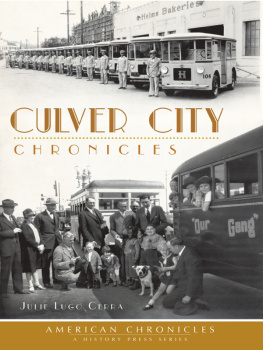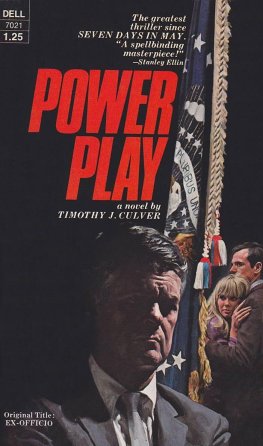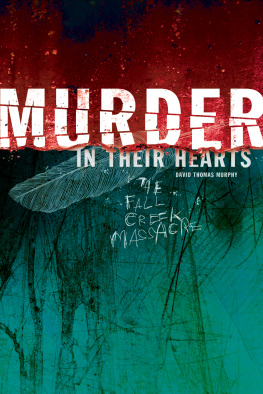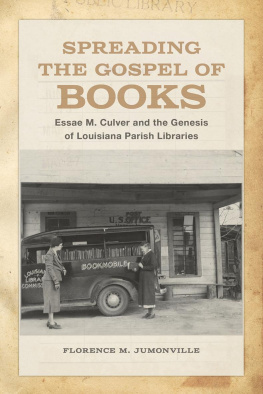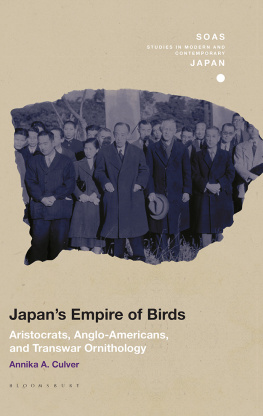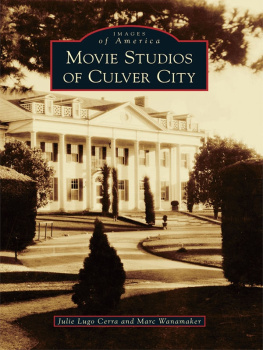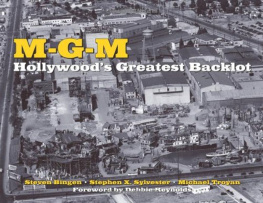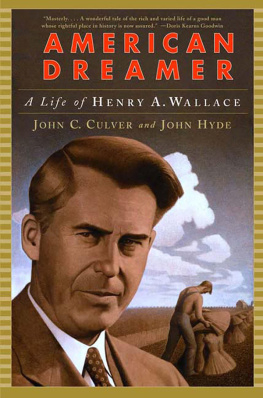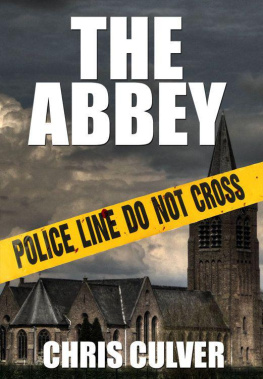
Published by The History Press
Charleston, SC 29403
www.historypress.net
Copyright 2013 by Julie Lugo Cerra
All rights reserved
All photos courtesy of the author unless otherwise noted.
First published 2013
e-book edition 2013
Manufactured in the United States
ISBN 978.1.61423.876.8
Library of Congress CIP data applied for.
print edition ISBN 978.1.60949.777.4
Notice: The information in this book is true and complete to the best of our knowledge. It is offered without guarantee on the part of the author or The History Press. The author and The History Press disclaim all liability in connection with the use of this book.
All rights reserved. No part of this book may be reproduced or transmitted in any form whatsoever without prior written permission from the publisher except in the case of brief quotations embodied in critical articles and reviews.
CONTENTS
ACKNOWLEDGEMENTS
It all started with a favor in 1979, when my mother asked if I would take my dad to a Culver City Historical Society formation meeting. Daddy had flunked retirement three times, and he clearly needed more than golf. Mother declared, Hell be a natural! And she was right.
This presented an opportunity to enjoy time with my dad and learn more about the Lugo family heritage, which started in California in 1774. Born on the Lugo Ranch in 1908 in what would become Culver City, my father had a unique perspective and much to offer. Little did I know that we would become founding society members and take leadership roles with total family involvement.
Special thanks to Steve Hadland for the opportunity to write Ask Julie (which transitioned into Looking Back) columns for the Culver City News. This anthology is culled from more than four hundred of those articles.
I am especially grateful for family support in this quest for knowledge of what my little brother Carlos calls the olden days. We have learned firsthand from many early settlers and their descendants. My husband, Sam, used to proof work for me, but that task has fallen to my very literate and bright daughter Michele, who was our youngest tour guide. Michele, her husband, Kevin, and little Nicholas offer fabulous family support.
Thanks to Steve Rose and the Culver City Chamber of Commerce, which gave me the opportunity to write my first book; Darrell Fusaro for the opportunity to interview for Local History, Legends and Lore; the Culver City Historical Society for keeping me interested and making me stretch with Living History Programs; and the Culver City News for opportunities to broaden my horizons. And thanks to Aunt Jean Barker, Fred Cuz Machado, the Culver familyespecially Robert Battleand locals like June Caldwell, Martha Sigall, the Pittis, Ray Moselle, Stu Freeman and Marc Wanamaker, who have shared their stories and photos and answered many questions. A special thanks to the city for access to records.
INTRODUCTION
Culver City boasts a rich history, from the Native Americans and early settlers to visionary Harry H. Culvers dream for a balanced community through development and major redevelopment. Culver City continues to thrive as the Heart of Screenland. Just walk around downtown Culver City at lunchtime and youll see that studio IDs are a reminder of the presence of the entertainment industry and its broad base of support. Although many locals still miss the MGM sign, Sony Pictures Entertainment has been an extraordinary corporate citizen for more than twenty years.
The Gabrielinos used this land with respect, leaving fertile ground for the generations of early settler families like the Machados, Talamantes, Higueras, Ybarras, Saenz, Rochas, Lugos and others.
Statehood and other changes yielded new opportunities that city founder Harry Culver noted and used to develop the kind of community that brought families together in his Home City. Culvers business acumen laid the foundation for an economic base that ensures a good, solid life with all the amenities.
Harry Culvers leadership brought people to a temperate place halfway between the growing pueblo of Los Angeles and Abbot Kinneys resort of Venice. He planned for success and the promise of a little community growing out toward the big city.
This is the story of the many people who shared the common goals that have yielded Culver Cityan oasis within the urban metropolis and a city with a rich history.
CHAPTER 1
THE EARLY TIMES
OUR NATIVE AMERICANS
There was evidence of life in this area dating back to about 6000 BC. Some attribute the arrival of those early peoples to the land bridge that existed across the Bering Strait. However, there is little definitive evidence showing those ancients as the forebears of the Gabrielinos who inhabited this coastal area at the time of Spanish discovery and settlement.
The Native Americans we think of as local were called the Gabrielino Indians due to their proximity to the San Gabriel Mission, which was established in 1771. In all probability, their ancestors migrated from what became Oregon and Nevada through California deserts. They were Shoshonean (of Uto-Aztecan linguistic stock) and had impressive vocabularies, according to some. Because their history was passed down by word of mouth and since they lost their native languages in the colonization of California, our interest is often far greater than definitive information.
The Gabrielinos were social, peaceful people who lived in villages in Los Angeles (Yang-na) and Playa del Rey. They settled areas along water and lived in families (less organized than tribes) in huts called jacals or wickiups. These dome-shaped structures were quite large, framed in willows and thatched with tule grass, which was plentiful along Ballona Creek. A hole in the roof allowed smoke to escape, and hanging partitions offered privacy, as more than one family often lived together.

An artistic representation of the legend of Torovim, a Tongva chieftain who fled an enemy tribe by jumping from a cliff into the ocean and changing into a dolphin, or torovim, their brother in the ocean. This artwork was unveiled on April 28, 2000, on a cliff at Loyola Marymount University overlooking the ocean to commemorate that legend with the further explanation that the dolphin swims around the world as a protector and caretaker of the ocean.
La Ballona Valley offered water, safety and an abundance of food. The Gabrielinos constructed reed boats called bolsas or wooden plank canoes, both sealed with asphaltum from the location nearby known today as the La Brea Tar Pits or from deposits on the sandy beaches. They settled on high ground but moved through areas like ours to gather food. The Gabrielinos were also expert basketmakers. They constructed baskets for their everyday needs, including cooking acorns, which required the use of hot rocks in the water. They waterproofed their baskets with the same asphaltum used on the boats.
Acorns were considered the Gabrielinos consistent food staple, but these Native Americans also hunted small animals, dug edible roots and picked berries. Acorns were gathered by the community at large and stored. After cracking and shelling them, the Gabrielinos made acorn mush by pounding them and then leaching the bitter acid from them in hot water. Beyond acorns, food gathering and preparation was mostly divided by gender. The elderly women and children generally gathered plant materials, seeds, beans and roots. Seeds were gathered using a beater that knocked them into flat baskets. They also ate pine nuts, walnuts and the fruits of cactus.
Next page
